
Kirov is the largest city and administrative center of Kirov Oblast, Russia. It is located on the Vyatka River in European Russia, 896 kilometres (557 mi) northeast of Moscow. Its population was 518,348 in 2020, up to roughly 750 thousand residents in the urban agglomeration.

Azov, previously known as Azak, is a town in Rostov Oblast, Russia, situated on the Don River just 16 kilometers (9.9 mi) from the Sea of Azov, which derives its name from the town. Population: 81,924 (2021 Census); 82,937 (2010 Census); 82,090 (2002 Census); 80,297 (1989 Census).
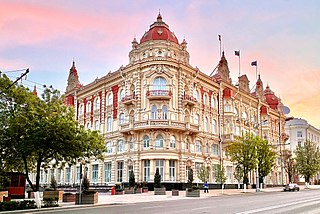
Rostov-on-Don is a port city and the administrative centre of Rostov Oblast and the Southern Federal District of Russia. It lies in the southeastern part of the East European Plain on the Don River, 32 kilometers (20 mi) from the Sea of Azov, directly north of the North Caucasus. The southwestern suburbs of the city lie above the Don river delta. Rostov-on-Don has a population of over one million people and is an important cultural center of Southern Russia.

Vladimir is a city and the administrative center of Vladimir Oblast, Russia, located on the Klyazma River, 200 kilometers (120 mi) east of Moscow. It is served by a railway and the M7 motorway. Population: 349,951 (2021 Census).
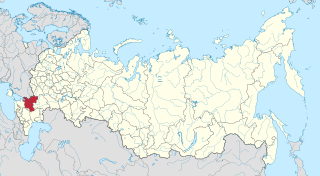
Rostov Oblast is a federal subject of Russia, located in the Southern Federal District. The oblast has an area of 100,967 square kilometers (38,984 sq mi) and a population of 4,200,729, making it the sixth most populous federal subject in Russia. Its administrative center is the city of Rostov-on-Don, which also became the administrative center of the Southern Federal District in 2002.

Suzdal is a town that serves as the administrative center of Suzdalsky District in Vladimir Oblast, Russia, which is located on the Kamenka River, 26 kilometers (16 mi) north of the city of Vladimir. Vladimir is the administrative center of the surrounding oblast. As of the 2021 Census, its population was 9,286.

Novocherkassk is a city in Rostov Oblast, Russia, located near the confluence of the Tuzlov and Aksay Rivers, the latter a distributary of the Don River. Novocherkassk is best known as the cultural capital of the Cossacks, and as the official capital of the Don Cossacks. Population: 168,746 (2010 Census); 170,822 (2002 Census); 187,973 (1989 Census).

A roundhouse is a type of house with a circular plan, usually with a conical roof. In the later part of the 20th century, modern designs of roundhouse eco-buildings were constructed with materials such as cob, cordwood or straw bale walls and reciprocal frame green roofs.
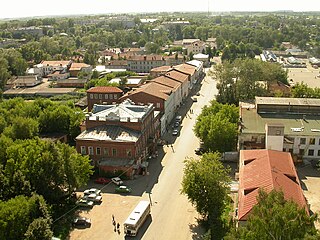
Kashin is a town and the administrative center of Kashinsky District in Tver Oblast, Russia, located around a rural agricultural area on the Kashinka River. Population: 16,171 (2010 Census); 17,299 (2002 Census); 21,186 (1989 Census); 18,000 (1970).
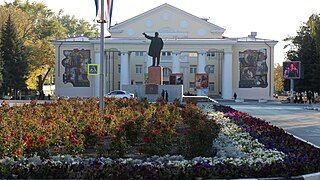
Gukovo is a mining town in Rostov Oblast, Russia, located close to the border with Ukraine. Population: 66,648 (2002 Census); 67,336 (1989 Census).

The southern Russian city of Taganrog began as one of Russia's first planned cities under Peter the Great. To protect the newly conquered Sea of Azov region, the Russians opened a naval base there in 1698 and a city and seaport were built. However, after the Turkish victory in the war of 1710–1711, Taganrog city and port were demolished prior to handover to the Turks.

Aksay is a town and the administrative center of Aksaysky District in Rostov Oblast, Russia, located on the right bank of the Don River, 18 kilometers (11 mi) northeast of Rostov-on-Don, the administrative center of the oblast. Population: 41,969 (2010 Census); 38,012 (2002 Census); 33,389 (1989 Census). It was previously known as Ust-Aksayskaya, Aksayskaya.

Sebezhsky District is an administrative and municipal district (raion), one of the twenty-four in Pskov Oblast, Russia. It is located in the southwest of the oblast and borders with Rasony and Verkhnyadzvinsk Districts of Vitebsk Oblast of Belarus in the south, Zilupe, Ludza, and Cibla municipalities of Latvia in the west, Krasnogorodsky and Opochetsky Districts in the north, and with Pustoshkinsky and Nevelsky Districts in the east. The area of the district is 3,100 square kilometers (1,200 sq mi). Its administrative center is the town of Sebezh. Population: 21,674 (2010 Census); 25,473 ; 26,926 (1989 Census). The population of Sebezh accounts for 29.4% of the district's total population.
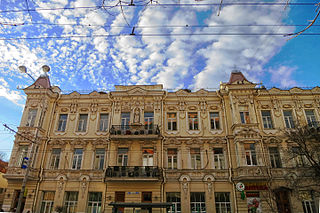
The Tokarev House is an edifice in the Kirovsky District of Rostov-on-Don, Russia. The house is located at 106 Bolshaya Sadovaya street at the intersection of Chekhova avenue and Bolshaya Sadovaya street. It was a revenue house. The building is also considered to be an object of cultural heritage.

Velikanova House is a mansion and an architectural monument in the city of Rostov-on-Don, Russia. It was built in 1884—1890 on the project of architects Nikolay Doroshenko and Nikolay Sokolov. Today the building is occupied by Rostov Art College named after M.B. Grekov.
The Fair in Rostov-on-Don was a regularly held trade event in Rostov-on-Don in the 19th century. It was traditionally organized at the same place and used to attract a large number of merchants and other visitors. Usually 3 major fairs were held in Rostov-on-Don every year.
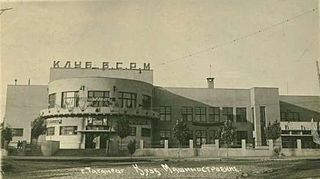
The Palace of Culture of the combine factory is the Taganrog Palace of Culture, which belonged to the Taganrog Combine factory.

Trading house of G.G. Pustovoytov is a building in Rostov-on-Don at the intersection of Bolshaya Sadovaya and Budennovskiy avenue.
Alexander Dmitrievich Dmitrev was a Soviet historian, researcher of popular movements in the Roman Empire, religious scholar, Doctor of Historical Sciences, and professor.
The Donbas–Rostov Strategic Defensive Operation was a defensive operation of the Southern Front and the left wing of the South–Western Front of the Red Army on the territory of Donbas during the World War II. During it, the Donbas and Rostov front–line defensive operations were carried out.



















